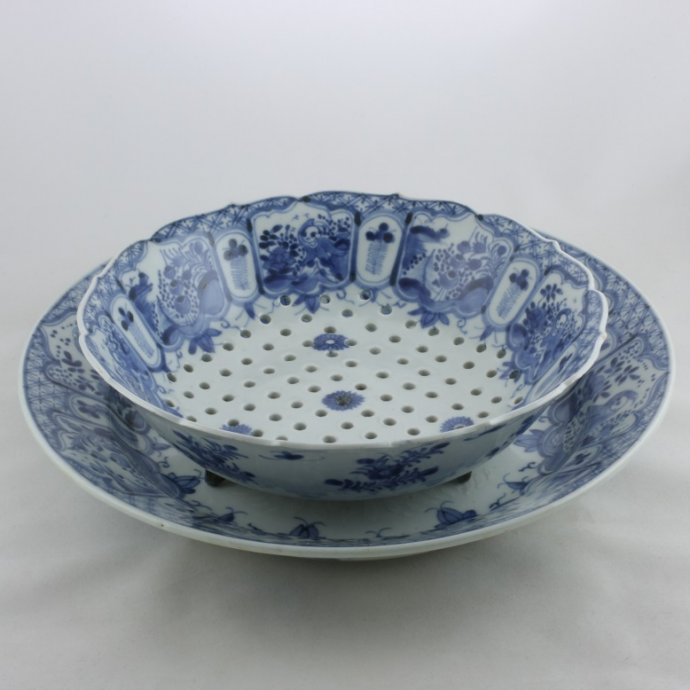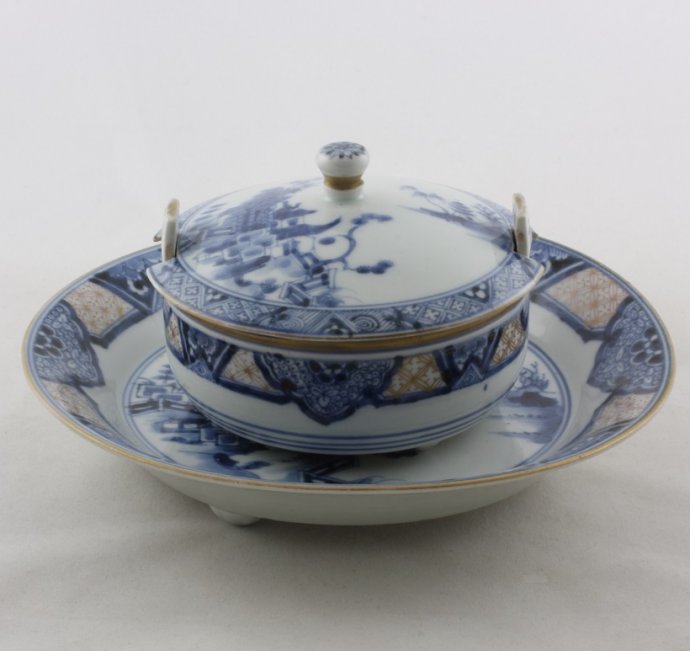Sold Ceramics
Sold Japanese Blue and White wares 18th Century
Tableware and other Porcelain with Western Shapes
Page 1

Sold Ceramics - Sold Japanese Blue and White wares 18th Century - Tableware and other Porcelain with Western Shapes - Page 1
Objects 2011841 & 2011842
Strainer / colander and stand
Japan
1740-1750
Strainer / colander: Height 74 mm (2.91 inch), diameter of rim 235 mm (9.25 inch), diameter of base 120 mm (4.72 inch), weight 725 grams (25.57 ounce (oz.))
Stand: Height 55 mm (2.17 inch), diameter of rim 304 mm (11.97 inch), diameter of base 143 mm (5.63 inch), weight 982 grams (34.64 ounce (oz.))
Stand on footring, flat rim. Three spur-marks in a V-pattern on the base. The strainer / colander standing on three little tripod legs, the everted rim has a scalloped edge, the well is pierced with holes, the centre of the base is unglazed. Both stand and strainer / colander decorated in underglaze blue. The stand with an impressed central flower head, on the sides and rim petal-shaped panels enclosing alternately a young boy (Dutch: “zotje”) and a pagoda in a river landscape divided by narrow panels filled with a flower stem, reserved on a trellis diaper pattern ground. On the reverse eight flower sprays with an insect in between. The strainer / colander with four scattered flowers in the well in between and around the pierced holes. On the sides and rim petal-shaped panels alternately filled with a young boy (Dutch: “zotje”) and a pagoda in a river landscape divided by narrow panels filled with a flower stem, reserved on a trellis diaper pattern ground. On the reverse eight flower sprays with an insect in between. The matching stand was acquired at a later date.
O. Impey describes an identical strainer in his "Japanese Export Porcelain. Catalogue of the Collection of the Ashmolean Museum, Oxford", p. 111 cat. 133. He states that originally there probably would have been an accompanying stand with this strainer. For such complete sets, please see;
- Ko-Imari in Paris. Enchanting beauty: 350 years of Japanese porcelain exports to Europe / Pari ni saita Ko Imari no hana: Nihon jiki Yōroppa yushutsu 350-shūnen kinen, (O. Koji, Tokyo, 2009), p.174 & p.191, cat. 164.
- Chinese and Japanese Ceramics and Works of Art, auction catalogue Christie's Amsterdam 20 November 2001, sale 2528, lot 130.
Impey also mentions another identical strainer in the British Museum, London (inv. nr. BM 527). The Groninger Museum in the Netherlands has a third identical piece (Jörg 2011/1, p.202, cat. 68 ) Interestingly, there is also a Japanese Imari strainer in the collection of the Kyushu Ceramic Museum, dated 1700-1740. (Arita 2000, p.71, cat.123)
Already in 1683 all regular porcelain trade with Japan of the VOC directly bound for the Netherlands ceased. Inter-Asian trade for Batavia, Ceylon, Bengal Persia and other destinations did continue until 1757. This strainer was therefore most likely the result of a private commission. Judging by Dutch 18th century sales and inventories, Japanese porcelain was quite expensive at the time and even more highly valued than its Chinese counterpart. Even so, later 18th century pieces are quite rare in Dutch collections and more often found in England.
According to C.J.A. Jörg in his “Fine & Curious”, the heyday of Japanese porcelain with European forms seem to have been around 1700. Although these pieces after European models occur less frequently during the 18th century, he gives some examples of mid to late 18th century pieces made after Delft faience models, among which this strainer fits perfectly.
Jörg states in “Oriental Porcelain in the Netherlands. Interaction between East and West in the 17th century”, that this Japanese strainer also in all likeliness was modelled after a Dutch Delft example. This because of its “Europeanising style”, which is for example shown in the broad panels with figures, the small tripod legs and the scattered flowers round the holes, all of which can also be found on contemporary Delft pieces.
For some Delft examples, please see:
- Austrumu porcellans un Niderlande. Austrumu un Rietumu mijiedarbiba 17. gadsimta / Oriental Porcelain and the Netherlands. Interaction between East and West in the 17th century, (C.J.A. Jörg, Art Museum Riga Bourse, Riga, 2011), p.204, cat. 69
- Ceramics crossed overseas. Jingdezhen, Imari and Delft from the Collection of the Groninger Museum, (C.J.A. Jörg et al.,Tokyo 1999), p.91, cat. 121
- Arita - Delft - China, exhibition catalogue Arita Porcelain Park 1993, cat. 33
This particular type of underglaze blue strainer copying a Delft example is also seen in Chinese export porcelain, please see:
- Austrumu porcellans un Niderlande. Austrumu un Rietumu mijiedarbiba 17. gadsimta / Oriental Porcelain and the Netherlands. Interaction between East and West in the 17th century, (C.J.A. Jörg, Art Museum Riga Bourse, Riga, 2011), p.200, cat. 67
- Ceramics crossed overseas. Jingdezhen, Imari and Delft from the Collection of the Groninger Museum, (C.J.A. Jörg et al., Tokyo, 1999), p.90, cat. 119
D.S. Howard in his “The Choice of the Private Trader ”, p.132 cat.nr.139 also describes a Chinese strainer and plate of similar form, dated circa 1760, yet with famille rose enamels and a pseudo armorial. Howard states that this kind of plate and strainer were introduced by the Meissen Porcelain Factory and this particular strainer was probably made after a Meissen original.
The function of these strainers is not clear. Howard suggests that it was probably used for serving lettuce, which gained popularity in the 18th century because of its supposedly mild medicinal powers. Another possible use would have been to serve some kind of fruit or perhaps strawberries. Interesting in this regard is the existence of a signed Dutch Delft Doré strainer, dated circa 1740, which has in fact scattered strawberries instead of flowers in the well. (Christie’s New York, 20-21-1-2004, sale 1327, lot 615)
Condition:
Stand: Perfect.
Strainer / colander: A few firing flaws, small glaze rough spots along the edge and a chip to the rim.
References:
Price: Sold.

Sold Ceramics - Sold Japanese Blue and White wares 18th Century - Tableware and other Porcelain with Western Shapes - Page 1
Object 2011811
Butter tub
Japan
c.1750
Tub with cover: height 80 mm (3.15 inch), diameter of rim 112 mm (4.41 inch), diameter of base 95 mm (3.74 inch), weight with cover 353 grams (12.45 ounce (oz.)), weight cover 109 grams (3.84 ounce (oz.))
Dish: height 38 mm (1.49 inch), diameter of rim 197 mm (7.76 inch), diameter of biscuit base 135 mm (5.31 inch), weight 431 grams (15.20 ounce (oz.))
Butter tub with matching dish. The round tub on three small pointed feet, the base is unglazed. Two straight square flat handles on either side each with a pierced hole in the middle. Domed lid with knob and openings for the handles. The base of the dish with a broad biscuit band and three similar feet, the recessed centre glazed. Decorated in underglaze blue and gold with a river scene showing a pavilion, a gate and trees on the rocky bank. Near the pavilion two groups of square objects (rocks or racks?). Round the rim of the dish and the sides of the box a border with a diaper pattern in gold and reserved ruyi-shaped and trapezoid panels filled with stylised flowers. The dish is marked with the character ka (a syllable) in underglaze blue. (Jörg 2003/1, pp.180-181, cat. 221)
The shape is ultimately derived from a Dutch butter tub made of wood with reed bands and flat, pierced handles. However, the Japanese potter modelled this piece after a Chinese butter tub of a similar shape. These were made between 1740-60 and usually have no saucer. Several Chinese butter buts of this shape but with a different decoration were found in the wreck of the VOC ship, the Geldermalsen (1752), and are described in the cargo list as 'butter tubs'. The decoration on this piece closely imitates the Chinese model. An identical set was in the Impey collection. (Jorg 1986, p.87, cat. 77). (London 1997, pp.142-143, cat 80)
For identically shaped and decorated butter tubs with matching dishes, please see;
- Ko-Imari from the collection of Oliver Impey, (Barry Davies Oriental Art, London, 1997), pp. 142-143, cat. 80.
- Fine & Curious. Japanese Export Porcelain in Dutch Collections, (C.J.A. Jörg, Hotei Publishing, Amsterdam, 2003), pp.180-181, cat. 221.
- Ko-Imari in Paris. Enchanting beauty: 350 years of Japanese porcelain exports to Europe / Pari ni saita Ko Imari no hana: Nihon jiki Yōroppa yushutsu 350-shūnen kinen, (O. Koji, Nihon Keizai Shinbunsha, Tokyo 2009), p.191, cat. 165
For an identically shaped and decorated butter tub dish, please see;
Condition:
Tub with cover: A shallow fleabite to the rim of the tub.
Dish: Perfect.
References:
Price: Sold.


 create websites
create websites